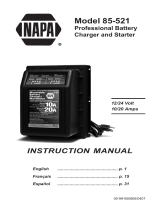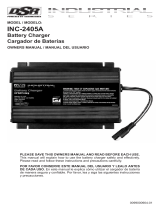
1
Owner's Manual
Battery
Charger
Model:
–Save–
Important Safety Instructions
#MC-1
1 Amp Manual
Battery Charger for 6 and 12 Volt
Batteries
Read Rules for Safe Operation and Instructions Carefully
Working in vicinity of a lead-acid battery is dangerous. Batteries generate explosive gases during normal
battery operation. For this reason, it is of utmost importance that each time before using your charger, you
read this manual and follow the instructions exactly.
WARNING: Handling the cord on this product or cords associated with accessories sold with this product, will expose you to lead, a
chemical known to the State of California to cause cancer and birth defects or other reproductive harm.
Wash hands after handling.
00-99-000245/0404
SCHUMACHER ELECTRIC CORPORATION
801 BUSINESS CENTER DRIVE • MOUNT PROSPECT, ILLINOIS 60056-2179
Send Warranty Product Repairs to: 1025 E. Thompson, Hoopeston, IL 60942-0280
Call Customer Service if you have questions: 1-800-621-5485
INTRODUCTION
Your new 1-amp battery charger has been designed to provide
years of service. This instruction manual contains information on
safety, operation, and maintenance of your new charger. Make
sure that you are familiar with this information before using the
charger.
This charger is ideal for recharging batteries in snowmobiles, ATV’s,
garden tractors, and motorcycles.
IMPORTANT SAFETY INSTRUCTIONS SAVE THESE
INSTRUCTIONS
This manual contains important safety and operating instructions.
Do not expose to rain or snow.
The use of an attachment not recommended or sold by the charger
manufacturer may result in a risk of fire, electric shock, or injury to
persons. To reduce risk of damage to electric plug and cord, pull
by the plug rather than cord when disconnecting charger.
An extension cord should not be used unless absolutely neces-
sary. Voltage drops as length of cord increases. Use of improper
extension cord could result in a risk of fire and electric shock. If an
extension cord must be used, make sure that the:
a) pins on plug of extension cord are the same number, size and
shape as those of plug on charger.
b) the extension cord is properly wired and in good electrical
condition; and
c) wire size is large enough for AC ampere rating of charger as
specified below:
Length of cord (feet): 25 50 100 150
AWG size of cord: 18 18 16 14
Do not operate the charger with damaged cord or plug – replace
them immediately.
Do not operate charger if it has received a sharp blow, been
dropped, or otherwise damaged in any way; take it to a qualified
service person.
Do not disassemble charger; take it to a qualified service person
when service or repair is necessary. Incorrect assembly may re-
sult in a risk of electric shock or fire.
To reduce risk of electrical shock, unplug the charger from outlet
before attempting any maintenance or cleaning.
WARNING – Connect and disconnect the battery clamps or har-
ness only when the supply cord is disconnected or arcing may
result.
CAUTION – Do not expose to rain; replace damaged cords or
wires immediately.
WARNING – RISK OF EXPLOSIVE GASES.
To reduce the risk of battery explosion, follow these instructions
and those published by the battery manufacturer. Review the cau-
tionary markings on the charger and battery.
PERSONAL PRECAUTIONS
a) Someone should be within range of your voice, or close enough
to come to your aid, when you work near a lead acid battery.
b) Have plenty of fresh water and soap nearby in case battery
acid contacts skin, clothing, or eyes.
c) Wear eye protection and clothing protection. Avoid touching
eyes while working near a battery.
d) If battery acid contacts skin or clothing, immediately wash with
soap and water. If acid enters eye, immediately flood with
running cold water for at least 15 minutes and get medical
attention immediately.
e) Never smoke or allow a spark or flame in the vicinity of battery
or engine.
f) Do not drop a metal tool onto the battery. It might spark or
short-circuit the battery or other electrical part that may cause
an explosion.
g) Remove personal metal items such as rings, bracelets,
necklaces, and watches when working near a lead acid battery.
h)
Use the charger for charging a lead acid battery only It is not
intended to supply power to a low voltage electrical system
other than in an automotive application. Do not use battery
charger for charging dry cell batteries that are commonly used
with home appliances. These batteries may burst and cause
injury to persons or damage to property.
i) Never charge a frozen battery.
If necessary to remove battery from vehicle to charge, always
remove grounded terminal from the battery first. Make sure
all accessories in the vehicle are off, so as not to cause an arc.
PREPARING TO CHARGE
a) Be sure area around the battery is well ventilated while battery
is being charged. Gas can be blown away by using a piece of
card board or other non-metallic material as a fan.

2
b) Add distilled water in each cell until battery acid reaches level
specified by the battery manufacturer. This helps purge gas
from cells. Do not overfill. For a battery without cell caps,
carefully follow manufacturer’s instructions.
c) Study all battery manufacturer’s specific precautions such as
removing or not removing cell caps while charging and
recommended rates of charge.
d) Determine voltage of battery by referring to vehicle owner’s
manual and make sure that output voltage selector switch is at
correct voltage setting.
DANGER – Never alter the AC cord or plug provided – if it will
not fit outlet, have a proper outlet installed by a qualified
electrician. Improper connection can result in the risk of
electrical shock.
CHARGER LOCATION
a) Locate charger as far away from battery as DC cables permit
b) Never place charger directly above battery being charged.
c) Never allow battery acid to drip on charger when reading
specific gravity.
d) Do not operate charger in a closed-in area or restrict ventilation
in any way.
e) Do not set battery on top of charger.
DC CONNECTION PRECAUTIONS
Connect and disconnect DC clamps only after removing AC cord
from wall outlet. Do not permit clamps to touch each other.
OPERATING INSTRUCTIONS FOR CHARGING BATTERIES
Follow these steps when battery is installed in vehicle. A spark
near battery may cause battery explosion. To reduce the risk of a
spark near the battery:
a) Position AC and DC cords to reduce risk of damage by hood,
door, or moving engine parts
b) Stay clear of fan blades, belts, pulleys, and other parts that
can cause injury to persons.
c) Check polarity of battery posts. Positive battery post is usually
larger diameter than the Negative post.
d) Determine which post of battery is grounded (connected) to
the chassis. If negative post is grounded to the chassis (as in
most cases), see Item E. If Positive post is grounded to the
chassis, see Item F.
e) For negative grounded vehicle, connect Positive clamp from
charger to Positive ungrounded post. Connect Negative (Black)
clamp to vehicle chassis or engine block away from battery.
Do not connect to carburetor, fuel lines, or sheet metal body
parts. Connect to a heavy-gauge metal part of the frame or
engine block.
f) For positive-grounded vehicle, connect Negative (Black) clamp
from charger to ungrounded Negative (Black) post of battery.
Connect positive (Red) clamp to vehicle chassis or engine block
away from battery. Do not connect to carburetor, fuel lines, or
sheet metal body parts. Connect to a heavy-gauge metal part
of the frame or engine block.
g) When disconnecting charger, disconnect AC cord, remove
clamp from vehicle chassis, and then remove clamp from
battery post.
Follow these steps when battery is outside of vehicle:
a) Check polarity of battery posts. Positive battery post is usually
a larger diameter than the Negative post.
b) To keep a safe distance from the battery, attach at least a 24-
inch long, 18-gauge or heavier insulted jumper cable to the
Negative battery post.
c) Connect Positive (Red) charger clamp to Positive post of the
battery.
d) Position yourself and free end of the cable as far away from
the battery as possible, then connect the Negative clamp to
the free end of the cable. Do not face battery when making this
final connection.
e) When disconnecting charger, always do so in reverse sequence
of connecting procedure and disconnect the first connection
while as far away from the battery as possible.
f) A marine (boat) battery must be removed and charged on shore.
To charge it on board requires equipment specially designed
for marine use.
CHARGER MAINTENANCE AND CARE
Clean the clamps each time you are finished charging. Wipe off
any battery fluid that may have come in contact with the clamps to
prevent corrosion.
Coil the input and the output cords neatly when storing the charger.
This will prevent accidental damage to the cords and charger.
CHARGER CONTROLS
The 1-amp charger has a Volt Selector switch on the front of the
charger. Match the charging voltage 6 or 12 volts to the battery
being charged.
INDICATION OF A FULLY CHARGED BATTERY
A hydrometer reading of the specific gravity of the electrolyte (fluid)
of the battery in good condition should be between 1.25 and 1.285.
When the battery reaches 80–85% of full charge, bubbles will ap-
pear on the surface of the fluid. As the battery nears full charge,
bubbling will become more vigorous.
CHARGING TIMES
This charger has a rated output of 1 ampere with an expected
finish charge rate of .3 amperes. These outputs will vary with the
age and condition of the battery being charged.
Amp Hour Average Charge
Battery Capacity Times in Hours
2 2 – 2.5
44 – 5
6 6 – 7.5
10 10 – 12.5
12 12 – 15
20 20 – 25
WARNING: This is a manual battery charger. Charging must be
monitored to prevent overcharging of the battery.
CIRCUIT BREAKER
This battery charger is equipped with a self-resetting circuit breaker.
This device protects the charger from temporary overloads. In the
event of an overload, the breaker will trip open and after a short
cooling off period will reset automatically. This process is known
as cycling and can be recognized by an audible clicking sound.
LIMITED WARRANTY
SCHUMACHER ELECTRIC CORPORATION, 801 BUSINESS CENTER DRIVE,
MOUNT PROSPECT, ILLINOIS 60056-2179 MAKES THIS LIMITED WARRANTY TO
THE ORIGIONAL PURCHASER AT RETAIL OF THIS PRODUCT. THIS LIMITED
WARRANTY IS NOT TRANSFERABLE.
Schumacher Electric Corporation warrants this battery charger for two years from date
of purchase at retail against defective material or workmanship. If such should occur,
the unit will be repaired or replaced at the option of the manufacturer. It is the obliga-
tion of the purchaser to forward the unit together with proof of purchase, transportation
and/or mailing charges prepaid to the manufacturer or its authorized representative.
This limited warranty is void if the product is misused, subjected to careless handling,
or repaired by anyone other than the factory or other authorized factory representative.
The manufacturer makes no warranty other than this limited warranty and expressly
excludes any implied warranty including any warranty for consequential damages.
This is the only express limited warranty and the manufacturer neither assumes nor
authorizes anyone to assume or make any other obligation towards the product other
than this express limited warranty. The manufacturer makes no warranty of merchant-
ability or fitness for purpose of this product and expressly excludes such from this
limited warranty. Some states do not allow the exclusion or limitation of incidental or
consequential damages or length of implied warranty so the above limitations or exclu-
sions may not apply to you. This warranty gives you specific legal rights, and you may
have other rights which vary from state to state.
Page is loading ...
Page is loading ...
/


